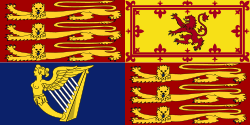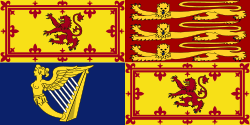Sunninghill Park
Coordinates: 51°25′34″N 0°39′00″W / 51.426040°N 0.649894°W Sunninghill Park is a country house and estate of some 665 acres (2.69 km2; 1.039 sq mi), located north of Cheapside, in the civil parishes of Sunninghill and Ascot and Winkfield, adjoining the south-western boundary of Windsor Great Park in the English county of Berkshire. It was the official residence of the Duke of York from 1990 until 2004.
First house
Sunninghill Park was originally part of Windsor Forest until 1630 when King Charles I granted it to Thomas Carey. In circa 1633, it was purchased by Sir Thomas Draper and sold in 1769 by his great grandson, Thomas Draper Baber, to Jeremiah Crutchley, whose family owned it until perhaps the death of Percy Edward Crutchley in 1940. (Crutchley's maternal grandparents were the owners of Eldon House in London, Ontario). [1] The first significant house was built on the estate in the late Georgian period in the early 19th century, being a stucco building of two stories with later additions.[2]
It served as the headquarters of the American Ninth Air Force from November 1943 to September 1944. The Crown Estate Commissioners purchased the property in 1945, from the late Philip Hill. The main house was made available to Princess Elizabeth (later Queen Elizabeth II) and her future husband Philip, Duke of Edinburgh, for after their marriage in November 1947, but the house burned down on 30 August 1947 before they could occupy it, so they rented Windlesham Moor instead.[3] In the mid-1960s the site was considered for a new home for Princess Margaret, Countess of Snowdon, but this did not happen.
Second house


In 1986[4] the walled garden of some 5 acres (20,000 m2; 220,000 sq ft) was purchased from the Crown Estate Commissioners on behalf of Queen Elizabeth II. The following year construction began on a two-storey red brick house to be the home of the Duke and Duchess of York. The architect responsible was Sir James Dunbar-Nasmith, Balmoral Estate Architect and Professor and Head of the Department of Architecture at Heriot-Watt University.[5] Construction was completed in 1990.
The house has six reception rooms, 12 bedrooms, and 12 bathrooms, and compares in size to the larger country houses built since the Second World War. Sunninghill Park was the first newly built royal home since Bagshot Park was built in 1879 for the Duke of Connaught. In the British tabloid press the home was often referred to as 'SouthYork' a play on words for the 'Southfork' estate on the popular 1980s soap opera Dallas, and was also "mocked for its resemblance to a Tesco-style supermarket".[5]
Following the death of Queen Elizabeth The Queen Mother in 2002, it was announced that the Duke of York planned to move out of Sunninghill Park and into Royal Lodge, Windsor, the Queen Mother's former residence.[6] Until 2004, the Duke of York and his former wife shared the family's home. In 2007, the Duchess rented Dolphin House, and became next door neighbours with her ex-husband. He moved in 2004, following refurbishment of Royal Lodge, funded by taking out a mortgage on Sunninghill Park.[7] HM Land Registry records show that the house was sold for £15 million in 2007, £3 million over the asking price, to an offshore trust in the British Virgin Islands.[5][8][9] Kenes Rakishev, a 29-year- old Kazakhstan businessman who calls himself a 'friend' of Prince Andrew, has admitted negotiating the deal with the help of his father-in-law Imangali Tasmagambetov, the mayor of Astana; but insists neither of them is the owner.[5] The British press have speculated that the most likely owner is his business partner, Timur Kulibayev, the billionaire son-in-law of the Kazakh president, Nursultan Nazarbayev.[5][10]
On 24 February 2009, the Daily Mail newspaper reported that the house has been allowed to fall into an increasingly derelict state.[10] In July 2009, Bracknell Forest Borough Council were said to be considering seizing the property under the Housing Act 2004 and using it as a homeless shelter, following several reported break-ins.[11]
References
- ↑ Robin and Terry Harris, eds. The Eldon House Diaries: Five Women's views of the 19th century' Toronto: Champlain Society, 1994, page 343.
- ↑ Ditchfield, P. H. and Page, William, ed. (1923). "Sunninghill". A History of the County of Berkshire: Volume 3. pp. 134–136.
- ↑ "Surrey home for princess". The Canberra Times. 8 January 1948. p. 1. Retrieved 4 July 2010.
- ↑ Prince Andrew's £15million former royal residence could be seized and used for the homeless Daily Mirror
- ↑ 5.0 5.1 5.2 5.3 5.4 Foggo, Daniel; Swinford, Steven (27 July 2008). "Prince Andrew, his £15m home and the Kazakhstan connection". The Sunday Times (London). Retrieved 4 July 2010.
- ↑ "Will of Queen Elizabeth The Queen Mother". The Royal Household. 17 May 2002. Retrieved 4 July 2010.
- ↑ Kay, Richard (10 August 2004). "Mortgage misery for Andrew". Daily Mail (London). Retrieved 4 July 2010.
- ↑ Bates, Stephen (1 March 2009). "From royal fairytale to crumbling eyesore: the mystery of Prince Andrew's old home". The Guardian (London). Retrieved 4 July 2010.
- ↑ Mendick, Robert; Alderson, Andrew (30 May 2010). "Prince Andrew and the Kazakhstan connection". Daily Telegraph (London). Retrieved 4 July 2010.
- ↑ 10.0 10.1 English, Rebecca (24 February 2009). "The fall of the house of York: why has the mansion sold by Duke in mystery £15m deal gone to ruin?". The Daily Mail (London). Retrieved 4 July 2010.
- ↑ Boniface, Susie (19 July 2009). "Exclusive: Prince Andrew's £15 million former royal residence could be seized and used for the homeless". Daily Mirror. Retrieved 4 July 2010.
External links
- Frith photo circa 1901 of the first house and great pond
- Pathé film of the first house after it was destroyed by fire

